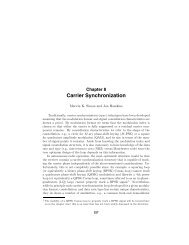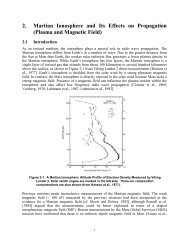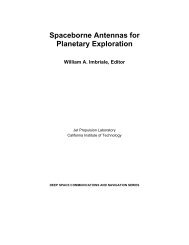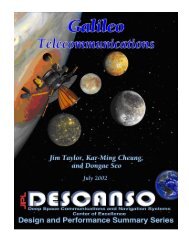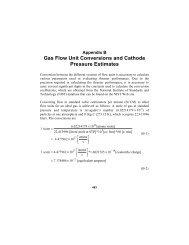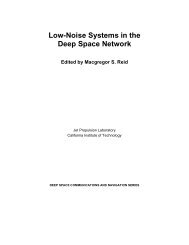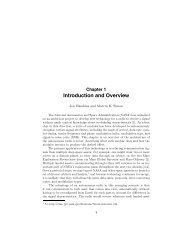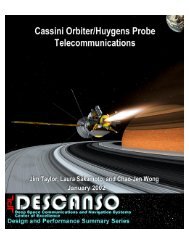Propagation Effects Handbook for Satellite Systems - DESCANSO ...
Propagation Effects Handbook for Satellite Systems - DESCANSO ...
Propagation Effects Handbook for Satellite Systems - DESCANSO ...
Create successful ePaper yourself
Turn your PDF publications into a flip-book with our unique Google optimized e-Paper software.
phase variation between two points separated by a distance pa normal<br />
to the direction of propagation, given an estimate of C no.<br />
Clearly, this phase incoherence appears as an apparent antenna<br />
gain degradation. Measurements made with a 22 m diameter antenna at<br />
5 degrees elevation angle and 4 and 6 GHz indicate a 0.2 to 0.4 dB<br />
degradation (Yokoi, et al-1970). A 7 meter diameter antenna at 5<br />
degrees elevation angle and 15.5 and 31.6 GHz yielded a gain<br />
degradation<br />
This effect<br />
frequencies<br />
564-3) .<br />
of 0.3 and 0.6 dB, respectively (Yamada and Yokoi-1974).<br />
is clearly most pronounced <strong>for</strong> large antennas~ high<br />
and elevation angles below 5 degrees (CCIR 1986b, Rpt.<br />
6.5.4 Anqle-of-Arrival Variation<br />
The average ray bending (mean deviation from the geometric or<br />
vacuum line-of-sight) alo-ng a slant path has been estimated by a<br />
linear relation to the surface refractivity (Crane-1976a).<br />
Estimates of the apparent fluctuations of ray direction or the<br />
angle-of-arrival are given below. Because they are assumed to arise<br />
solely due to refractive effects the variations are symmetrical<br />
about the direction of propagation and the fluctuation frequency is<br />
of the order of the time <strong>for</strong> the turbulence length to pass through<br />
the beam.<br />
The Muchmore and Wheelon expression <strong>for</strong> the rms angle-of-arrival<br />
fluctuation in radians is<br />
‘e =<br />
where all parameters are as previously defined. A Gaussian<br />
correlation function <strong>for</strong> the scale of turbulence was assumed and one<br />
should impose the limits<br />
2x<br />
J<br />
~-4m-l —2 -2 -1<br />
s AN /g S2 x 10 m<br />
6-94<br />
(6.5-8)<br />
(6.5-9)<br />
.





